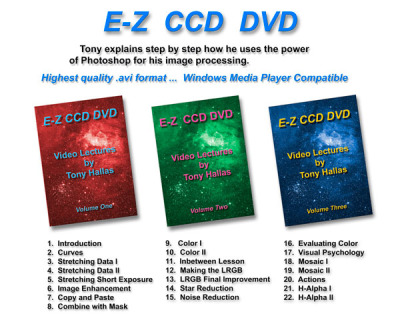A new tool for astrophotography enhancement
 EZ CCD DVD by Tony Hallas is a new tool for the astrophotographer to improve their image enhancement skills. I just completed viewing the 3 DVD set and here are the answers to your questions:
EZ CCD DVD by Tony Hallas is a new tool for the astrophotographer to improve their image enhancement skills. I just completed viewing the 3 DVD set and here are the answers to your questions:
- Is it worth the $68? Yes. You have to remember, as much as I have studied Photoshop and processing, I still approach the subject as "unknowable." I always learn something from every course I digest. What I particularly like about this DVD series is that you are basically sitting at Tony's side as he works through M81 processing from post-reduction to final print. You work through stretching of luminance and application of RGB with the utmost attention to detail. This is the definition of Fine Art Photography.
- Will it make my images better? Yes. There were moments when I had the DVD running on my laptop with my M31 open in Photoshop and applied the current lesson to the image. The image was improved by at least 20% through these new approaches. In particular, application of the spunge and high pass filters were most useful for this image.
- Will I learn something? Yes. I have studied with many of the country's top landscape photographers and image enhancement and compositional consideration were a part of those instructions. I still learned many new techniques and more importantly how to apply them at my artistic taste.
- Who is this for? Are your frustrated with your image processing? Do you not know how to effectively use masks and filters to enhance selected parts of your image? Do you have a pretty good understanding of Photoshop, but want to go a bit deeper into the water? Then this DVD set is for you.
The DVDs contain video files of Tony lecturing during his workflow in addition to some lectures on color, visual psychology, mosaic construction, and hydrogen alpha enhancement. The DVDs are focused on enhancing 16 bit fit files converted to TIFF, which is a bit different from my current workflow with RAW converted DSLR images. So my stretching of TIFF data is a bit different than what Tony presents, but after the lecture on stretching, all other techniques are certainly viable for any astrophotographer regardless of how the data was captured.
I had to chuckle on his "green gun" technique as I recall when he introduced that to the old film astrophoto list many years ago. It is still a very viable technique and one that every astrophotographer should be aware of.
What I like most about Tony's presentation is that he is first and foremost an artist with a vision. You may or may not find his final art product to your liking, that is the nature of the beast, but what he does do is share with you what is possible and encourages you to explore those possibilities that match your own artistic voice. That is what is really important, developing your own artistic eye. While it is important to be keenly aware of the enhancement tools at your discretion, ultimately it is your ability as an artist to visually interpret the data and present it in a way that meets your artistic vision and pleases your intended audience.
That is exactly what I like to focus on when working with imagers, finding their own artistic vision and reconciling their work to meet that vision. If you find yourself not satisfied with your work, you know that something is just not right, give me a call and we can discuss some of the ways to find meet your vision through your image optimization approach.
You can purchase the DVD set directly from Tony here or from Astro-Physics here.
